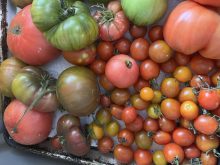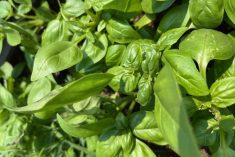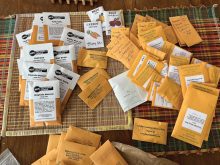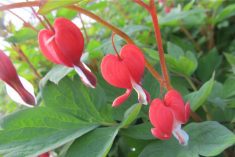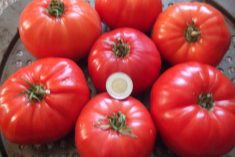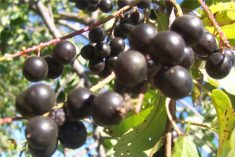Hummingbird seed blends are available consisting of 16 species of both annuals and perennials. When in bloom such flowers are irresistible to hummers attracting them to no end. I’ll provide names of some flowers found in such seed mixtures.
Making homemade sugar and water drink is on my list of another thing we can do for hummingbirds so keep tuned. Those words remind me of my radio days. A suggested recipe follows further along on this page and you don’t need a pen and paper handy to write it down as I’m not giving it “over the air.” By the way, gardeners aren’t shy about taking pictures, so if you’ve caught a few hummingbirds in flight action, email me a pic or two with a few details and I’ll feature some in future Grainews issues. Make sure the pics are of good size and high res.
Have you ever heard of teaching the kids how to grow a summer sunflower house? It’s an outdoor, fresh-air project that can involve the entire family. Seems to me they say grownups are sometimes “still a kid at heart.” I’ll share the instructions with you further along. Just keep reading for a few more minutes and you’ve found the right spot.
Read Also

Gentle treatments for pain in the neck
Heading toward year-end, people unknowingly tense up against the cold and busyness, causing neck pain that can often be treated with appropriate support and gentle mobility, athletic therapist Kathlyn Hossack says.
I’m loving printed words and advertisements on paper more than ever. So my good people, keep your eyes focused on the printed pages as we move along together for another stroll of words in this edition of Grainews. Thanks again for joining me. As I’ve said before — don’t know what I’d do without you. I’d hate to be like a lonely little petunia in an onion patch.
I recently replaced one of my Canadian flags. Those winter winds wreaked havoc on it, but my weather-beaten piece of headgear still withstands the test of time and does a formidable job here and now with a tip of the brim and a welcome to each and every one out there.
Got hummingbird feeders? Make your own hummingbird food
Here are some tips, information and shortcuts that will save time and money and attract hummers in no time flat. You may be surprised at how expensive a bottle of sugar water costs at some stores. The economical way is to make your own. An avid hummingbird promoter tells me that the correct ratio is 1:4 when making hummingbird sugar water at home. That is to say: one part sugar to four parts water and is based on similarity to flower nectar sweetness. Research indicates that a stronger mixture such as 1:3 is significantly sweeter and can interfere with the bird’s digestion and is best avoided. Combine sugar and water in a large heavy saucepan. Boil over medium-high heat for one minute until the sugar has completely dissolved, stirring constantly. Mould and bacteria are possible issues when the sugar and water combo aren’t sterilized by boiling. Remove from heat and set aside to cool to room temperature. Another source says to use cane sugar. If it doesn’t say cane on the label it is not sugar cane. Said cane sugar is usually more expensive so I suspect most folks make hummingbird sugar water using regular white sugar. To be responsible for the health of the hummingbird means we need to keep the syrup as close to a natural nectar mixture as possible by using the 1:4 ratio of one part sugar to four parts water. Adding food-grade red colouring isn’t necessary. Also, do not use honey, jelly powders, raw sugar, corn syrup, turbinado, molasses, brown sugar or anything artificial. Putting hummingbirds on a diet with anything other than sugar and water can be detrimental, harmful or kill them. They burn prodigious amounts of energy for their size and need flower nectar or appear to do well on sugar water. Again — do not add red food-grade colouring as it’s not necessary.
Reviewing the sugar-water recipe
Hummingbird sugar water has only two ingredients — sugar and water. To make your own for hummingbird feeders, add one cup of sugar to four cups of water. Lightly boil this mixture, stirring well for one minute and remove from heat, then cool. Boiling too long can cause a lot of water to evaporate as steam and makes the sugar and water concentration stronger. When the sugar-water solution has completely cooled, it is ready to pour into clean feeders. Store any that’s left over in the fridge. Depending on number of feeders set out, be prepared to be surprised by volume of hummers you’ll attract. They are literally known to swarm feeders all summer long and are known to consume eight litres of your sugar-water tonic weekly — and yes, some of them like to scrap for dominance.
Sunflower history, multiple uses
Sunflowers symbolize happiness, a positive attitude, long life with wellness and optimism. Heaven knows we all need these more than ever now. Sunny faces track the sun with their flower heads turning as the sun moves across the sky. This is known as heliotropism; hence their botanical reference of Helianthus annuus (annual).
Sunflowers are incredibly useful in organic gardening, earning their keep, long before and after harvest. They are an excellent lure for bees, other pollinators and beneficial insects. Plus, they’re a great asset for distributing such pollinators throughout a garden. Even a single sunflower growing here or there among squash and pumpkin vines is a bonus as garden pollinators discover there are blossoms hidden beneath large leaves. Sunflowers grow very quickly and are also known to eliminate toxins from the soil such as lead, arsenic and uranium. Health benefits to humans from eating raw sunflower seeds — even as little as a handful a day — is a story unto itself. Sunflowers originated in North America and domestic seeds dating back to 2100 BC have been found in Mexico. Aboriginals grew sunflowers as a crop, and explorers brought the flowers to Europe in the 1500s. Later, sunflowers became increasingly popular throughout Asia with Russian farmers growing over two million acres in the early 19th century, most of which were used to manufacture sunflower oil.

Guidelines to growing a sunflower summer house
Sunflowers grow best on a site that catches full sun in soil that’s evenly moist and well drained. Make sure you have access to additional water for daily hand watering if required in event of a dry, hot, windy growing season. Select the size and shape that you want your sunflower house to be. Sprinkle flour on the ground to designate where the outer sunflower walls will grow. Remove any weeds and grass in a one-foot area all along the perimeter line and plant seeds in this cleared area either in a single row or multiple rows if you want to create thicker sunflower walls. Leave at least one unplanted opening big enough to serve as the doorway for entry. Another option is to plant tallest sunflowers as inner walls and shorter varieties as outer walls on the outside. This provides twice the thickness of growth and more sunflowers can mean a sturdier sunflower summer house with more fun and greater attraction for kids. Again, a reminder that adult supervision and guidance should be maintained when growing a summer sunflower house for youngsters.
Sunflower varieties and hummingbird seed blend
There are far too many to name them all. The Tall Sunflower Blend from West Coast Seeds (1-888-804-8820) contains most of the best-known giants such as Titan, Russian Mammoth and Giganteus to provide a mixed planting of enormous seed heads on tall stalks that looks great. Solar Power shown on this page is an ornamental that produces numerous branches, bearing impressive pollenless flowers up to six inches across on 5-1/2-feet-tall stalks.
The hummingbird seeds mixture includes 16 species of annuals and perennials that includes Columbine Giant, Dwarf Spurred snapdragon, Lemon Mint, Wild petunia and Rocket Larkspur. As a side dressing, consider a long hedge of annual lavatera that can be direct seeded outdoors. These hibiscus-like flowers come in abundance in several colours that cast an aura of shimmering splendour for weeks on end, much to the delight of hummingbirds, insect pollinators and homeowners.




